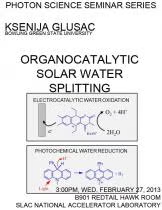Ksenija D. Glusac, Bowling Green State University
In search for earth-abundant catalysts for solar water splitting, we study fully organic compounds that can be used as catalysts for oxygen and hydrogen evolution. In specific, two projects will be reviewed in this presentation: (i) electrocatalytic water oxidation by a flavinium cation (Et-Fl+), and (ii) photochemical water reduction by an acridine derivative (Acr-H).
The electrocatalytic water oxidation by Et-Fl+ was observed at high overpotentials (+1.9 V vs. SHE) and the process was found to be assisted by the oxides formed on the electrode’s surface. Based on initial electrochemical studies, a mechanism is proposed in which the oxygen evolution occurs from a peroxide formed between oxidized flavin pseudobase intermediate Et-FlO+ and the oxide formed on the electrode surface.
The photochemical water reduction using Acr-H derivative was studied using steady-state and time-resolved UV/Vis spectroscopy. While the molecular hydrogen is formed during this process, the yield is very low (2%), likely due to the reduction of co-solvent. It was determined that the overall hydride release occurs in two steps: electron transfer followed by hydrogen-atom transfer. This mechanism was discussed with respect to the thermodynamics for stepwise and concerted hydride release pathways.





